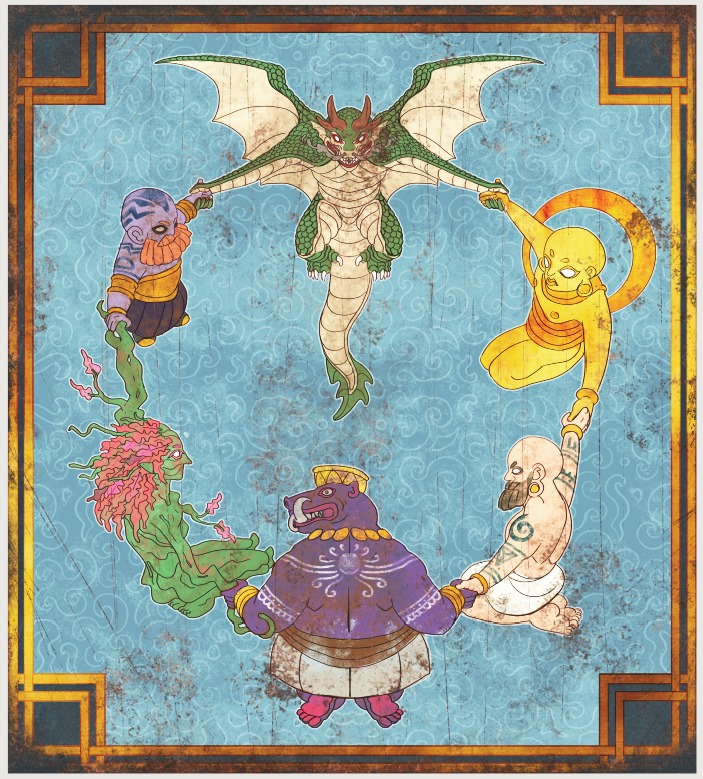A few more notes on Changing Gods. At the Dawn, the Thunderer and the Adventurer were often worshiped as separate gods. Pretty quickly the Theyalans recognised both as aspects of Orlanth, and that with a little preparation, a Thunderer could draw on Adventurer’s magic and vice versa. And both were pathways to Orlanth. And so very quickly they became Orlanth Thunderous and Orlanth Adventurous.
Were they originally different gods? Or just aspects of the same? Does it even make sense to talk about the divine in that way? What is clear is that it is easier and more useful to worship Orlanth as having a Thunderer aspect and an Adventurous aspect than to worship them as separate gods. While it is more useful to worship Orlanth as being separate from Storm Bull (although there have been efforts to say they are the same).
Sometimes things that were once thought possible are proven to be no more. So once there were those in Ralios who said Orlanth and Humakt were the same god. But since the end of the First Age it has not been possible to wield Humakt’s magic through Orlanth or vice versa.
![]()
![]()
And note that this all long predated the God Learners. Mortal efforts to better understand the divine go back to the beginning.
The God Learners had at least no stats in the way we are used to them. The God Learners might have rated divine manifestations by a Runic and power level system (“I detect a manifestation of Air 15 with Movement 10 and something I don’t quite understand.”)
Here’s another thing – mortals worship the gods and wield their powers for mortal reasons. Tradition, utility, understanding, ambition, whatever – all are present. Tradition tends to keep things the same, but utility and ambition are powerful motives for change. And so how mortals interact with the gods changes with Time. Some changes are the result of sudden discovery that “If I do it this way, I get Much More Magic!”
And so that mortal who discovered that Thunderer and Adventurer are both aspects of Orlanth was no doubt challenged by those who traditionally worshiped just one or the other. And that mortal displayed Orlanth’s magic – Lightning AND Thunderbolt. Large Elementals AND Flight. Shield AND Thunderstone. And more. All witnessed him manifest Orlanth’s full range of power. He passed all the tests and proofs and none could stand against him. And so all agreed that Orlanth is the Thunder AND the Adventurer.
That’s how this stuff happens in Glorantha. And survival is perilous enough that when someone proves they wield greater magic, that is a VERY convincing argument.
What if an individual suddenly wielded Orlanth magic while worshipping an obscure aspect of Humakt, claiming to have retraced the ancient pathways linking the two via heroquesting? A few basic ground rules of these tests – the person has to be able to participate in the inner rites of the cult (in this case Humakt). That’s the place only those initiated can perceive. That gets witnessed. They need to be able stay within the rites, without being forced out by guardian spirits and so on.
And within the inner rites, you need to display your power and either be accepted by the spirits present (that’s the preferred route) or be able to defeat those spirits and entities that come to force you out (not preferred).
But if you can do that, you are not an imposter. Unless later on it is shown you used trickery – Eurmal magic or Lunar deceptions. But that is always a danger.
There is a Divine in Glorantha and we can experience it and interact with it. But it is Beyond Us. The God Time has all the archetypes and stories, and our experience of it will contradict that of others. Our experiences and interactions are all true, but limited and blinkered by our mortal existence.
There is sometimes a modern compulsion that the divine somehow be a lie, a conspiracy, a mere trick. And at times Eurmal shows up and deceives us, but his deceptions are part of the divine experience!
At the Dawn, many communities knew “Orlanth is the son of the Mountain Goddess and Great Air.” And heck, we have a mountain nearby. And so Orlanth was born atop Thunder Mountain. Or atop Imther Mountain. Or Bear Peak. Or whatever.
But meanwhile those Heortlings clustered around Kero Fin gained special magic from the relationship – magic not replicated elsewhere. Except Top of the World, which granted its own magic. And so here’s the real question – is Kero Fin and Top of the World just manifestations of the same Mountain Goddess aspect and can we use Top of the World’s magic the same way we do Kero Fin’s?

